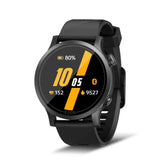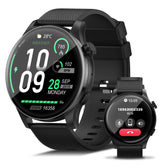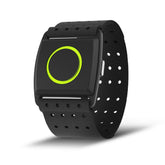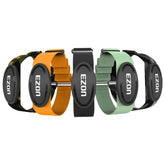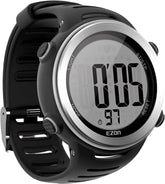トレーニング中の健康的な心拍数:詳細
トレーニング中の心拍数を理解することは、フィットネスと全体的な健康を最適化するために不可欠です。心拍数は運動強度の重要な指標として機能し、フィットネス目標を効果的に達成するためにトレーニングを調整することができます。この記事では、さまざまなトレーニング中の健康的な心拍数の科学的根拠、さまざまな運動強度が心拍数に与える影響、そして心拍数の監視が健康にとってなぜ重要であるかを探ります。
健康的な心拍数とは何ですか?
心拍数は 1 分あたりの拍数 (bpm) で測定され、年齢、フィットネス レベル、身体活動の種類などの要因によって異なります。ほとんどの成人の健康的な安静時の心拍数は 60 ~ 100 bpm の範囲ですが、アスリートや身体活動が活発な人は、心血管の効率が向上するため、安静時の心拍数が低くなる場合があります。
最大心拍数の計算
運動時の目標心拍数ゾーンを決定するには、まず最大心拍数 (MHR) を知る必要があります。MHR を推定するのによく使用される式は次のとおりです。
MHR = 220 - あなたの年齢
たとえば、30 歳の人の推定 MHR は 190 bpm になります。
心拍ゾーンと運動強度
さまざまな心拍ゾーンを理解することで、特定のフィットネス目標に合わせてトレーニングを調整することができます。主な心拍ゾーンは次のとおりです。
1. 休息ゾーン(60~100 bpm)
これは安静時の心拍数です。アスリートの安静時の心拍数は 60 bpm 未満になる場合があり、これは心臓の状態が良好であることを示します。
2. 脂肪燃焼ゾーン(MHRの50〜70%)
- 心拍数の範囲: 30 歳の場合、約 95 ~ 133 bpm。
- 利点: このゾーンは、減量と持久力の向上に最適です。早歩き、軽いジョギング、ゆったりとしたペースでのサイクリングなどのアクティビティがこのカテゴリに該当します。
3. 有酸素ゾーン(MHRの70〜80%)
- 心拍数の範囲: 30 歳の場合、約 133 ~ 152 bpm。
- 利点: このゾーンは心肺機能を高め、有酸素能力を高めます。ランニング、水泳、サイクリングなどの中程度の強度の運動では、通常この範囲に留まります。
4. 無酸素ゾーン(MHRの80〜90%)
- 心拍数の範囲: 30 歳の場合、約 152 ~ 171 bpm。
- 利点: このゾーンはスピードとパワーを高めるのに最適です。高強度インターバルトレーニング (HIIT) や激しいスプリントトレーニングはこのカテゴリに分類されます。
5. 最大努力ゾーン(MHRの90〜100%)
- 心拍数の範囲: 30 歳の場合、約 171 ~ 190 bpm。
- 利点: このゾーンは通常、長期間持続できません。最大限の努力を短時間集中して行い、最高のパフォーマンスを得るためのトレーニングに使用されます。
トレーニング中の心拍数に影響を与える要因
1. 運動の強度
運動の強度は心拍数に直接影響します。強度の高い運動は心拍数の増加につながり、強度の低い運動は心拍数を適度な範囲に維持します。
2. 運動の種類
運動の種類によって心拍数の反応は異なります。
- 有酸素運動: ランニング、サイクリング、水泳などの運動は、持続的な性質のため、通常、心拍数が大幅に上昇します。
- 筋力トレーニング: ウェイトリフティング中は心拍数がそれほど上昇しないかもしれませんが、サーキットトレーニングや高反復セットでは休憩時間が最小限であるため、心拍数を高く保つことができます。
3. フィットネスレベル
身体的に健康な人は、安静時の心拍数が低いことが多く、最大心拍数を超えずに高い強度を維持できます。トレーニングを続けると、心血管系がより効率的になり、より少ない負担でより高い強度の運動が可能になります。
4. 水分補給と栄養
適切な水分補給と栄養は、心拍数の反応に重要な役割を果たします。脱水は心拍数の上昇につながる可能性がありますが、十分な燃料は最適なパフォーマンスを維持するのに役立ちます。
心拍数を監視することの重要性
男性用の心拍数モニターウォッチやフィットネストラッカーウォッチを使用すると、トレーニング体験が大幅に向上します。心拍数のモニタリングが不可欠な理由は次のとおりです。
1. リアルタイムフィードバック
心拍数モニターはリアルタイムのデータを提供するため、強度を調整し、希望する心拍数ゾーン内に留まることができます。
2. 進捗状況の追跡
時間の経過とともに、トレーニング中の心拍数反応の改善を追跡でき、心血管フィットネスと持久力の向上が示されます。
3. 過剰トレーニングの防止
心拍数をモニタリングすると、身体の限界を超えないようにすることで、オーバートレーニングを防ぎ、怪我のリスクを軽減できます。
4. ストレス追跡
最新のストレス追跡ウォッチの多くは、心拍変動 (HRV) を評価して、ストレス レベルや回復の必要性に関する洞察を提供します。
結論
トレーニング中の心拍数を理解して監視することは、フィットネス目標を達成し、全体的な健康を維持するために不可欠です。さまざまな心拍数ゾーンと、さまざまな要因が心拍数にどのように影響するかを認識することで、最適なパフォーマンスが得られるようにトレーニングを調整できます。トレーニングに最適なスポーツウォッチや心拍数モニターウォッチを使用すると、貴重な洞察が得られ、軌道に乗ることができます。心拍数管理の科学を取り入れて、自信を持ってフィットネスの旅を高めましょう。
